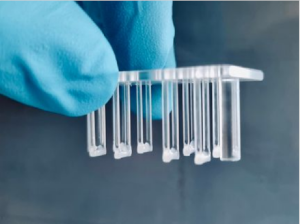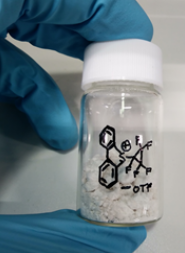
Scalable device for culturing and automatically measuring tissue engineered products
Tissue engineering has advanced over the last two decades and has the potential to replace traditional cell-based assays. Today, preclinical drug or toxin screening still relies on cell culture with poor predictive power. Scientists at the University of Göttingen have developed a new device for automated and reliable tissue engineering and drug testing.
read more

Pentafluorocyclopropanation of drugs and pesticides
The evaluation of the pentafluorocyclopropyl group as a chemotype in crop protection and medicinal chemistry has been hampered in the past by the lack of suitable methodologies that enable the practical incorporation of this moiety into advanced synthetic intermediates. By synthesizing an unprecedented sulfonium salt, 5-(pentafluorocyclopropyl)-dibenzothiophenium triflate, and using it as a versatile reagent for photoinduced pentafluorocyclopropylation, a wide range of (hetero)arenes are enabled by a radical-mediated mechanism.
read more
Kleines Protein — große Wirkung
Patenreife Entdeckung: TiHo-Wissenschaftler finden Protein, das Immunantwort bei Streptococcus suis-Infektionen hervorruft. MBM ScienceBridge vermittelt Vereinbarung zwischen der Stiftung Tierärztlichen Hochschule Hannover und IDT Biologika zur Übertragung sämtlicher Rechte an einer Hochschulerfindung.
Wissenschaftler aus dem Institut für Mikrobiologie der Stiftung Tierärztliche Hochschule Hannover (TiHo) erforschen seit Jahren die Infektionsmechanismen des Bakteriums Streptococcus suis. Je besser diese sogenannten Pathomechanismen bekannt sind, desto eher kann es gelingen Infektionen zu vermeiden oder zu bekämpfen. Hoffnung gibt jetzt ein Protein, das die Bakterien während des Infektionsvorganges bilden. Professor Dr. Peter Valentin-Weigand, Leiter des Institut für Mikrobiologie sagt: „Das von uns beschriebene Protein ruft bei infizierten Tieren eine Immunantwort hervor. Es soll als Grundlage genutzt werden, um einen neuartigen Impfstoff gegen Streptococcus suis-Erkrankungen bei Schweinen zu entwickeln.“
read more
Behandeltes einheimisches Holz wie exklusives Hartholz
MBM ScienceBridge GmbH vermittelt erfolgreich Lizenzvertrag über ein innovatives Holzbehandlungsverfahren zwischen der Georg-August-Universität Göttingen und TimTechChem International Limited.
Wissenschaftler an der Georg-August-Universität Göttingen haben eine innovative Behandlung von einheimischem Holz entwickelt. Dieses verbessert dadurch signifikant seine Eigenschaften wie z.B. Härte, Dauerhaftigkeit, Stabilität und Wasser & Wetter-Resistenz. So erlangt weiches einheimisches Holz die exklusiven Eigenschaften von tropischen Hartholz zu angemessenen Preisen.
Die in der Holzbehandlung verwendeten nicht-toxischen Substanzen verbinden sich unter Einwirkung von Druck mit den Cellulosefasern des Holzes. Die so erzielten Änderungen in der Zellulären Struktur erzeugen sogar Resistenz gegen Pilze. Somit sind die Eigenschaften und Leistungen von tropischem Hartholz werden erreicht, jedoch kann das behandelte Holz weiterhin normal verarbeitet und weiterbearbeitet werden. Das innovative behandelte einheimische Holz kann eingesetzt werden in hochwertigen Terrassen, Gartenprodukte, Gartenmöbel, Pflanzencontainer, Zäunen, Spielanlagen, Fassaden, Fenstern, Türen, Treppen, Böden, etc.
read more







